KIA MOHAVE 2014 User Guide
Manufacturer: KIA, Model Year: 2014, Model line: MOHAVE, Model: KIA MOHAVE 2014Pages: 417, PDF Size: 38.72 MB
Page 11 of 417
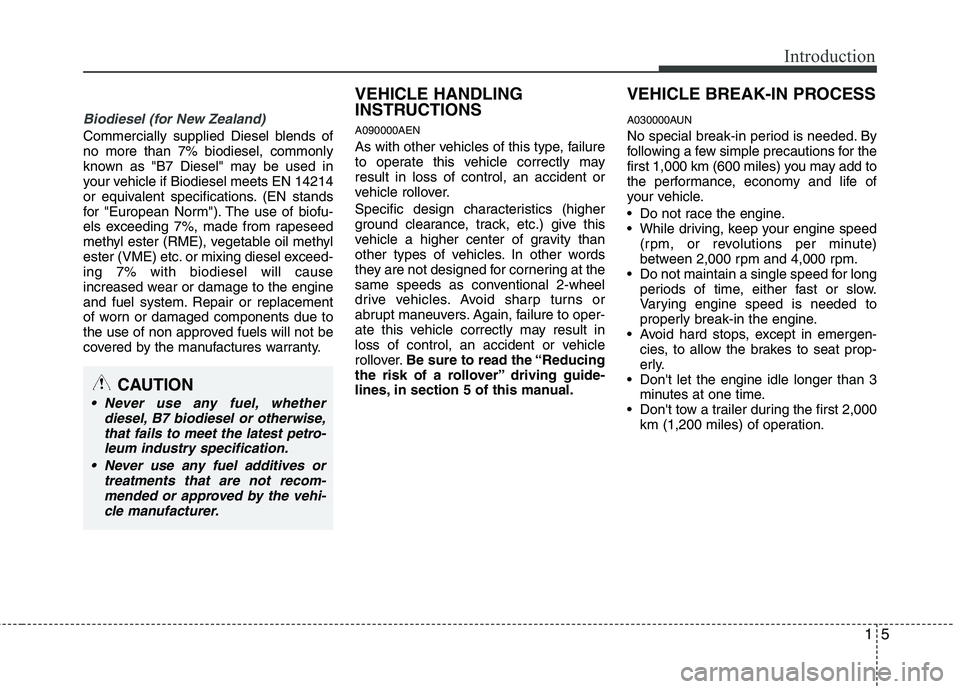
15
Introduction
Biodiesel (for New Zealand)
Commercially supplied Diesel blends of no more than 7% biodiesel, commonly
known as "B7 Diesel" may be used in
your vehicle if Biodiesel meets EN 14214
or equivalent specifications. (EN stands
for "European Norm"). The use of biofu-
els exceeding 7%, made from rapeseed
methyl ester (RME), vegetable oil methyl
ester (VME) etc. or mixing diesel exceed-ing 7% with biodiesel will cause
increased wear or damage to the engine
and fuel system. Repair or replacement
of worn or damaged components due to
the use of non approved fuels will not be
covered by the manufactures warranty.A090000AEN
As with other vehicles of this type, failure
to operate this vehicle correctly mayresult in loss of control, an accident or
vehicle rollover.
Specific design characteristics (higher
ground clearance, track, etc.) give this
vehicle a higher center of gravity than
other types of vehicles. In other words
they are not designed for cornering at the
same speeds as conventional 2-wheel
drive vehicles. Avoid sharp turns or
abrupt maneuvers. Again, failure to oper-
ate this vehicle correctly may result in
loss of control, an accident or vehicle
rollover.
Be sure to read the “Reducing
the risk of a rollover” driving guide-
lines, in section 5 of this manual. A030000AUN
No special break-in period is needed. By
following a few simple precautions for the
first 1,000 km (600 miles) you may add to
the performance, economy and life of
your vehicle.
Do not race the engine.
While driving, keep your engine speed
(rpm, or revolutions per minute)
between 2,000 rpm and 4,000 rpm.
Do not maintain a single speed for long
periods of time, either fast or slow.
Varying engine speed is needed to
properly break-in the engine.
Avoid hard stops, except in emergen- cies, to allow the brakes to seat prop-
erly.
Don't let the engine idle longer than 3 minutes at one time.
Don't tow a trailer during the first 2,000
km (1,200 miles) of operation.
CAUTION
Never use any fuel, whether
diesel, B7 biodiesel or otherwise,
that fails to meet the latest petro-leum industry specification.
Never use any fuel additives or treatments that are not recom-mended or approved by the vehi-
cle manufacturer.
VEHICLE HANDLING
INSTRUCTIONS VEHICLE BREAK-IN PROCESS
Page 12 of 417
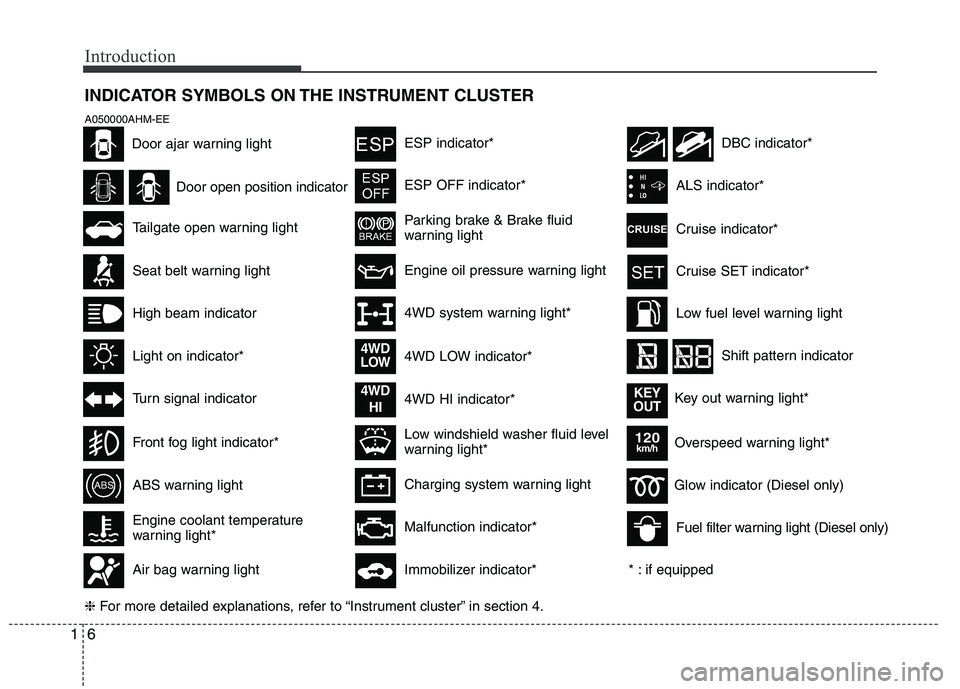
Introduction
6
1
INDICATOR SYMBOLS ON THE INSTRUMENT CLUSTER
Seat belt warning light
Door open position indicator
Tailgate open warning light
High beam indicator
Light on indicator*
Turn signal indicator
Front fog light indicator*
ABS warning light
Parking brake & Brake fluid
warning light
Engine oil pressure warning light
4WD system warning light*
4WD LOW indicator* 4WD HI indicator*
Malfunction indicator*
Air bag warning light
Cruise SET indicator*
ALS indicator*
Immobilizer indicator*
Low fuel level warning light
Shift pattern indicator
DBC indicator*
❈ For more detailed explanations, refer to “Instrument cluster” in section 4.
Charging system warning light
Low windshield washer fluid level
warning light*
Engine coolant temperature
warning light*
A050000AHM-EE
Door ajar warning light
Overspeed warning light*
120km/h
Key out warning light*KEY
OUT
4WD
LOW
4WD
HI
* : if equipped
Glow indicator (Diesel only)
Fuel filter warning light (Diesel only)
ESP OFF indicator*
ESP indicator*
Cruise indicator*
Page 13 of 417
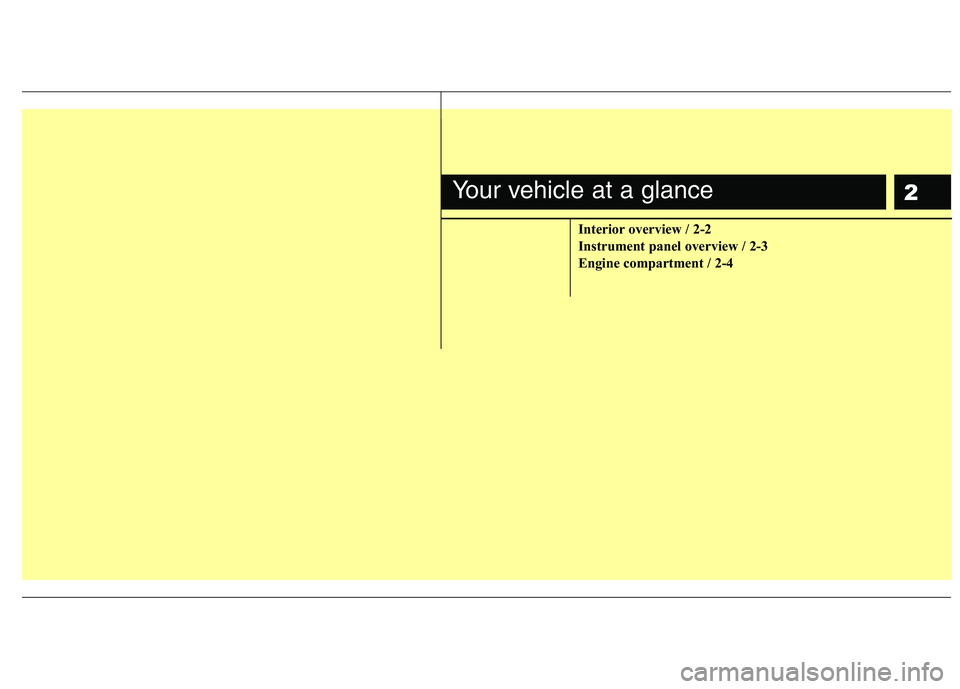
2
Interior overview / 2-2
Instrument panel overview / 2-3
Engine compartment / 2-4
Your vehicle at a glance
Page 14 of 417
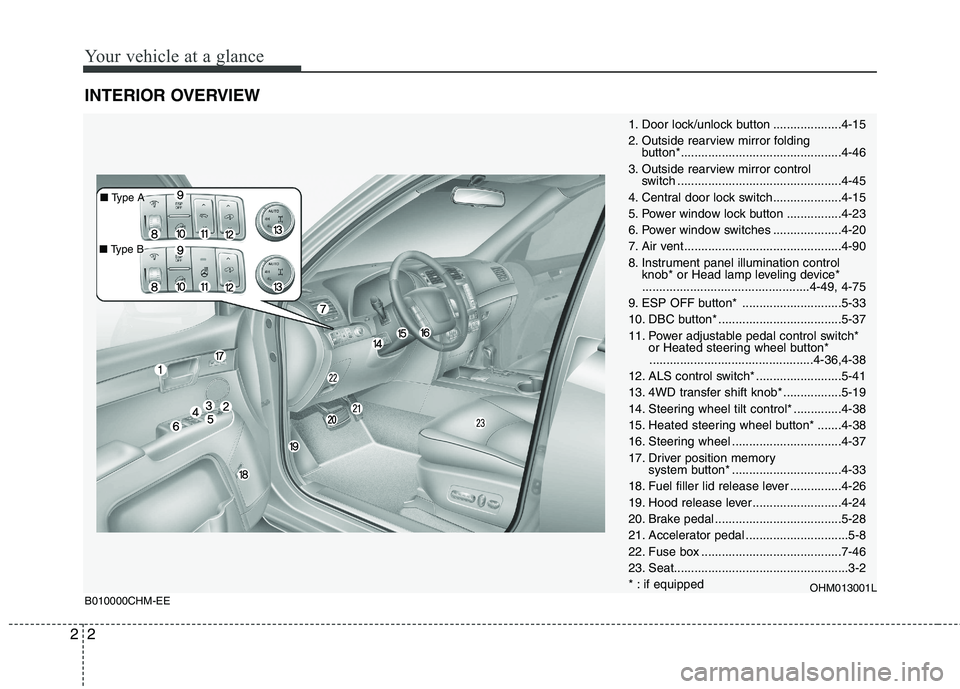
Your vehicle at a glance
2
2
INTERIOR OVERVIEW
1. Door lock/unlock button ....................4-15
2. Outside rearview mirror folding
button*...............................................4-46
3. Outside rearview mirror control switch ................................................4-45
4. Central door lock switch....................4-15
5. Power window lock button ................4-23
6. Power window switches ....................4-20
7. Air vent ..............................................4-90
8. Instrument panel illumination control knob* or Head lamp leveling device*.................................................4-49, 4-75
9. ESP OFF button* .............................5-33
10. DBC button* ....................................5-37
11. Power adjustable pedal control switch* or Heated steering wheel button*................................................4-36,4-38
12. ALS control switch* .........................5-41
13. 4WD transfer shift knob* .................5-19
14. Steering wheel tilt control* ..............4-38
15. Heated steering wheel button* .......4-38
16. Steering wheel ................................4-37
17. Driver position memory system button* ................................4-33
18. Fuel filler lid release lever ...............4-26
19. Hood release lever ..........................4-24
20. Brake pedal .....................................5-28
21. Accelerator pedal ..............................5-8
22. Fuse box .........................................7-46
23. Seat...................................................3-2
* : if equipped OHM013001L
B010000CHM-EE
■Type A
■ Type B
Page 15 of 417
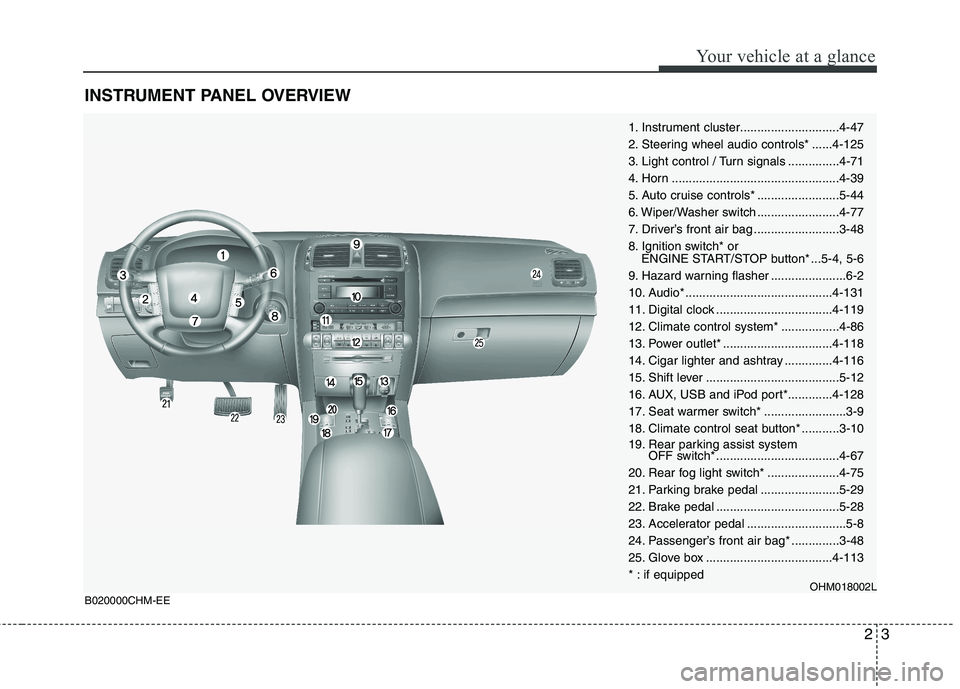
23
Your vehicle at a glance
INSTRUMENT PANEL OVERVIEW
1. Instrument cluster.............................4-47
2. Steering wheel audio controls* ......4-125
3. Light control / Turn signals ...............4-71
4. Horn .................................................4-39
5. Auto cruise controls* ........................5-44
6. Wiper/Washer switch ........................4-77
7. Driver’s front air bag .........................3-48
8. Ignition switch* orENGINE START/STOP button* ...5-4, 5-6
9. Hazard warning flasher ......................6-2
10. Audio* ...........................................4-131
11. Digital clock ..................................4-119
12. Climate control system* .................4-86
13. Power outlet* ................................4-118
14. Cigar lighter and ashtray ..............4-116
15. Shift lever .......................................5-12
16. AUX, USB and iPod port*.............4-128
17. Seat warmer switch* ........................3-9
18. Climate control seat button* ...........3-10
19. Rear parking assist system OFF switch* ....................................4-67
20. Rear fog light switch* .....................4-75
21. Parking brake pedal .......................5-29
22. Brake pedal ....................................5-28
23. Accelerator pedal .............................5-8
24. Passenger’s front air bag* ..............3-48
25. Glove box .....................................4-113
* : if equipped OHM018002L
B020000CHM-EE
Page 16 of 417
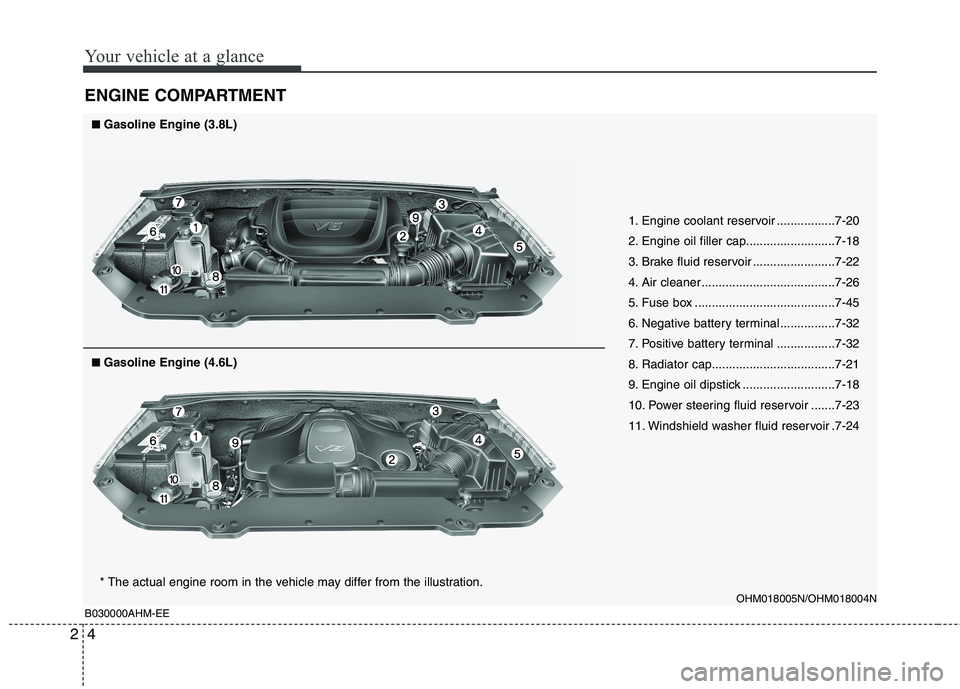
Your vehicle at a glance
4
2
ENGINE COMPARTMENT
B030000AHM-EE
1. Engine coolant reservoir .................7-20
2. Engine oil filler cap..........................7-18
3. Brake fluid reservoir ........................7-22
4. Air cleaner .......................................7-26
5. Fuse box .........................................7-45
6. Negative battery terminal ................7-32
7. Positive battery terminal .................7-32
8. Radiator cap....................................7-21
9. Engine oil dipstick ...........................7-18
10. Power steering fluid reservoir .......7-23
11. Windshield washer fluid reservoir .7-24 OHM018005N/OHM018004N
* The actual engine room in the vehicle may differ from the illustration.
■
■
Gasoline Engine (3.8L)
■■Gasoline Engine (4.6L)
Page 17 of 417
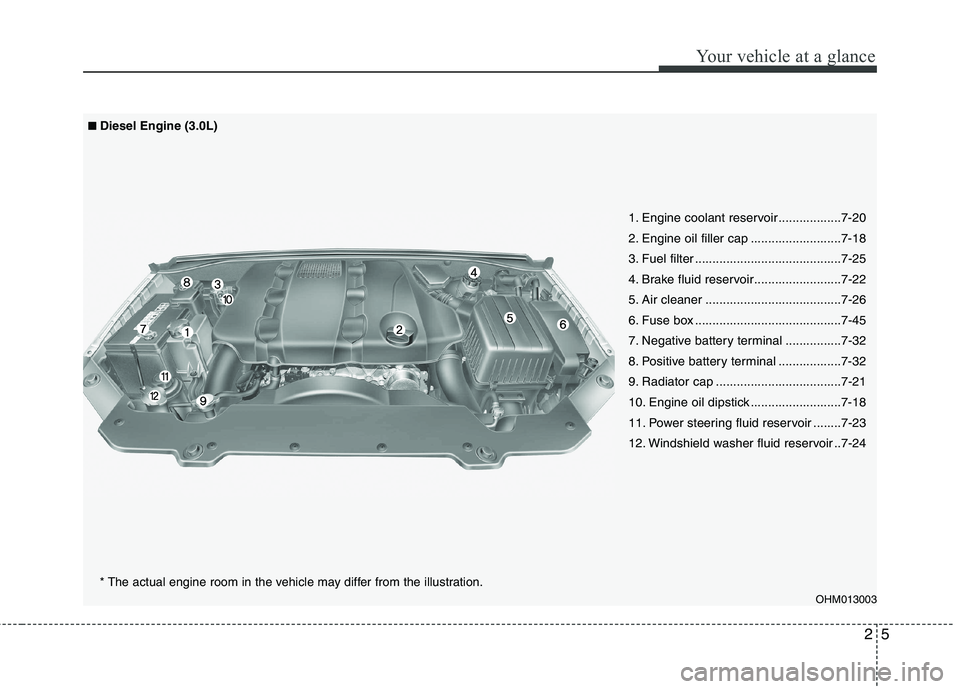
25
Your vehicle at a glance
OHM013003
1. Engine coolant reservoir ..................7-20
2. Engine oil filler cap ..........................7-18
3. Fuel filter ..........................................7-25
4. Brake fluid reservoir.........................7-22
5. Air cleaner .......................................7-26
6. Fuse box ..........................................7-45
7. Negative battery terminal ................7-32
8. Positive battery terminal ..................7-32
9. Radiator cap ....................................7-21
10. Engine oil dipstick ..........................7-18
11. Power steering fluid reservoir ........7-23
12. Windshield washer fluid reservoir ..7-24
■■Diesel Engine (3.0L)
* The actual engine room in the vehicle may differ from the illustration.
Page 18 of 417
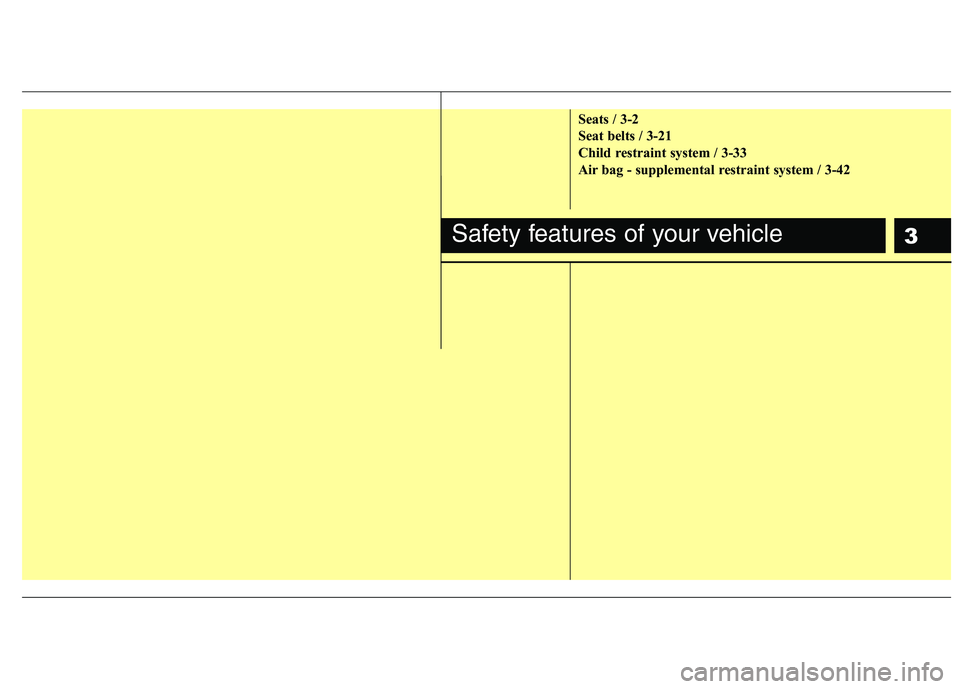
3
Seats / 3-2
Seat belts / 3-21
Child restraint system / 3-33
Air bag - supplemental restraint system / 3-42
Safety features of your vehicle
Page 19 of 417
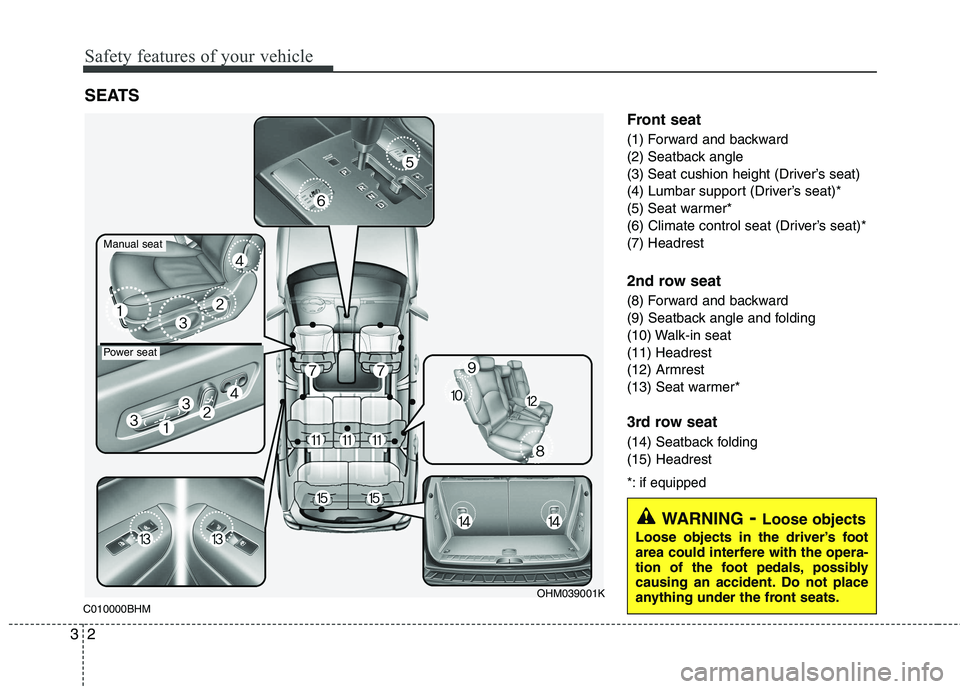
Safety features of your vehicle
2
3
C010000BHM Front seat
(1) Forward and backward
(2) Seatback angle
(3) Seat cushion height (Driver’s seat)
(4) Lumbar support (Driver’s seat)*
(5) Seat warmer*
(6) Climate control seat (Driver’s seat)*(7) Headrest
2nd row seat
(8) Forward and backward
(9) Seatback angle and folding
(10) Walk-in seat(11) Headrest
(12) Armrest
(13) Seat warmer*
3rd row seat
(14) Seatback folding (15) Headrest
*: if equipped
SEATS
OHM039001K
Manual seat
Power seat
WARNING
- Loose objects
Loose objects in the driver’s foot
area could interfere with the opera-
tion of the foot pedals, possibly
causing an accident. Do not place
anything under the front seats.
Page 20 of 417
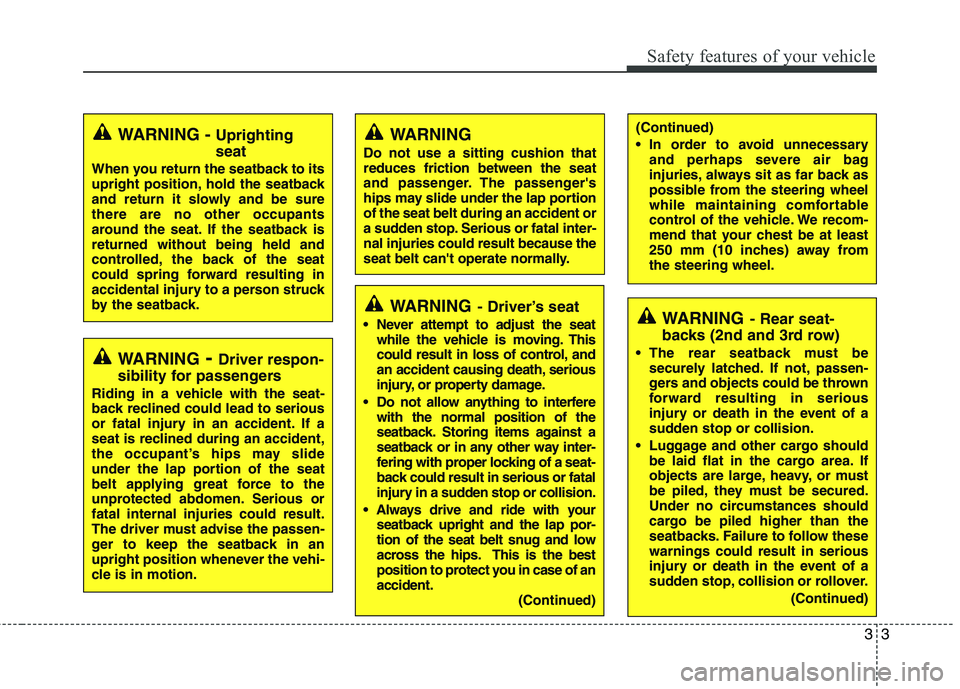
33
Safety features of your vehicle
WARNING- Driver’s seat
Never attempt to adjust the seat while the vehicle is moving. This
could result in loss of control, and
an accident causing death, serious
injury, or property damage.
Do not allow anything to interfere with the normal position of the
seatback. Storing items against a
seatback or in any other way inter-
fering with proper locking of a seat-
back could result in serious or fatal
injury in a sudden stop or collision.
seatback upright and the lap por-
tion of the seat belt snug and low
across the hips. This is the best
position to protect you in case of anaccident. (Continued)
(Continued)
In order to avoid unnecessaryand perhaps severe air bag
injuries, always sit as far back as
possible from the steering wheel
while maintaining comfortable
control of the vehicle. We recom-
mend that your chest be at least
250 mm (10 inches) away fromthe steering wheel.WARNING - Uprighting seat
When you return the seatback to its
upright position, hold the seatback
and return it slowly and be surethere are no other occupants
around the seat. If the seatback isreturned without being held and
controlled, the back of the seat
could spring forward resulting in
accidental injury to a person struck
by the seatback.
WARNING - Driver respon-
sibility for passengers
Riding in a vehicle with the seat-
back reclined could lead to serious
or fatal injury in an accident. If a
seat is reclined during an accident,
the occupant’s hips may slide
under the lap portion of the seat
belt applying great force to the
unprotected abdomen. Serious orfatal internal injuries could result.
The driver must advise the passen-
ger to keep the seatback in an
upright position whenever the vehi-
cle is in motion.
WARNING - Rear seat-
backs (2nd and 3rd row)
The rear seatback must be securely latched. If not, passen-
gers and objects could be thrown
forward resulting in serious
injury or death in the event of a
sudden stop or collision.
Luggage and other cargo should be laid flat in the cargo area. If
objects are large, heavy, or must
be piled, they must be secured.
Under no circumstances should
cargo be piled higher than the
seatbacks. Failure to follow thesewarnings could result in serious
injury or death in the event of a
sudden stop, collision or rollover.
(Continued)
WARNING
Do not use a sitting cushion that reduces friction between the seat
and passenger. The passenger's
hips may slide under the lap portionof the seat belt during an accident or
a sudden stop. Serious or fatal inter-nal injuries could result because the
seat belt can't operate normally.